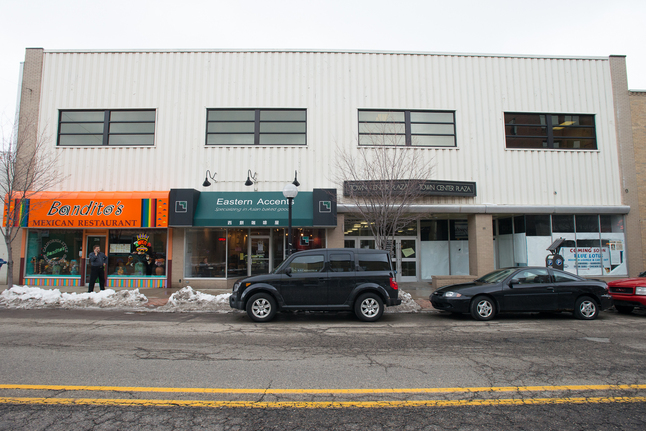Clik here to view.

The building at 210-216 S. Fourth sold this week to investor Joe Barbat.
Courtney Sacco | AnnArbor.com
After a foreclosure, the building at 210-216 S. Fourth Ave., just north of East Liberty Street, was sold to local investor Joe Barbat this week for a price that hasn’t yet been disclosed. Barbat, who has been silent about his plans for the property so far, is also the CEO of the Wireless Toyz franchise chain and real estate firm Barbat Holdings LLC.
As Barbat looks at how to redevelop, lease and possibly expand the Town Center Plaza building, here are some things he should consider:
- The building is in a prime location and it has potential.
When Carol Sun closed her 17-year-old Eastern Accents bakery at 214 S. Fourth in March, she said she had extensive issues with the way the building was managed by its former landlord, Dale Newman. She said it was plagued with maintenance issues that were often ignored.
But under new ownership, that could change, and the building could provide opportunity for businesses looking for space in downtown’s tight real estate market.
Clik here to view.

At one point, the building at 210-216 S. Fourth was known as the "Fourth Main Arcade" and it had a pedestrian walkway in the middle, but Thacher said that wasn't part of the original building's design.
Lizzy Alfs | AnnArbor.com
Tenants in Town Center Plaza include Bandito’s Mexican Restaurant, Salon Vertigo, Easy Pay Direct, Arbormoon Software and Ann Arbor Brazilian Jiu Jitsu Academy. It has several first and second floor vacancies that are now being marketed for lease with Colliers International’s Ann Arbor office, including two street-level spaces.
The building could play a key role in activating Fourth Avenue, which acts as a connector between downtown and the Kerrytown district. The block also has a number of independent restaurants and retailers.
“We think the building has tremendous potential,” said Arbormoon Software founder Dave Koziol. “It’s in a fabulous location.”
Added Bandito’s owner Ken Sing: “I’m just hoping (the ownership change) is for the best.” He said hopes to keep his Mexican restaurant in the building under the new owners.
- The facade needs a makeover.
Constructed in the 1920s, the roughly 20,000-square-foot Town Center Plaza building is considered a non-contributing building in the Main Street Historic District, said City Planner Jill Thacher.
She said the current aluminum facade was installed after a fire in the 1950s caused significant damage to the building. Although Barbat would need Historic District Commission approval to replace the facade, Thacher said the commission would “probably appreciate” an improvement.
- Expansion is possible, but limited.
Colliers’ Jim Chaconas said Barbat is considering how to give new life to the building. Architect Brad Moore of J Bradley Moore & Associates is in the process of evaluating the site.
Because the building is non-contributing, Thacher said the new owner has some leeway when it comes to redevelopment or expansion. She said it also might be possible to demolish and reconstruct the building, although Chaconas said it’s structurally intact.
Clik here to view.

It would be possible to construct some sort of addition on the Town Center Plaza building, which is currently two stories.
Kyle Mattson | AnnArbor.com
The property is located in the city’s D1 zoning, but because it’s in the Main Street Historic District, there are limitations on a building expansion. The historic guidelines say the addition’s footprint should not exceed half of the original building’s footprint, or half of the original building’s total floor area, but Thacher said that rule applies most often to standalone structures.
“This is a pretty deep building, so it might be possible to add some height on the back, but of course it all depends on the size and design. The impact on surrounding historic resources would also be taken into consideration,” Thacher said.
Lizzy Alfs is a business reporter for AnnArbor.com. Reach her at 734-623-2584 or email her at lizzyalfs@annarbor.com. Follow her on Twitter at http://twitter.com/lizzyalfs.